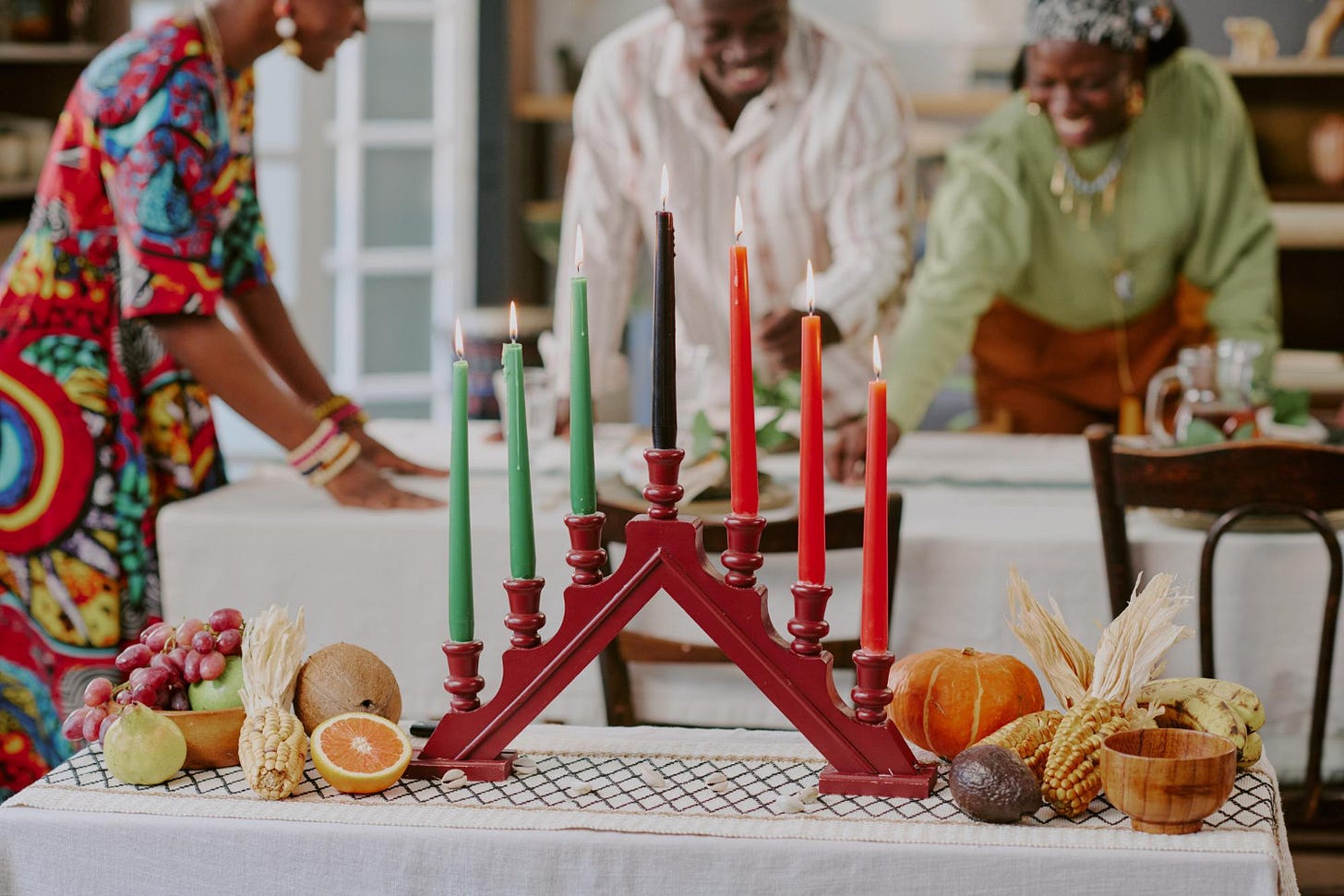📌 December Strategy: Weather, Mood and Revenue
Learn how to adjust your marketing to weather, guest mood and key cultural dates. Expert tactics you can apply today.
🌞 Hello and Welcome To Hospitality Marketing Insight
I’m your host, Dawn Gribble, and this week we’re looking at how December weather, mood and cultural moments shape what guests choose, when they book and how much they spend.
When daylight drops, so does serotonin, and spending shifts with it. Studies shows that social media activity can rise by over 35% on very cold days, while lighting that mimics sunlight can increase guests’ willingness to spend. Here’s how you can gain a competitive advantage.
📄 On the Menu this week
Weather, Mood & Momentum
Celebrating Kwanzaa
December Disasters - Marketing Mistakes to Avoid
Tactical Playbook: Mood-Based Messaging
Platform Updates & Expert Analysis
Marketing Dates for your Diary
Quick Wins Action Plan
Let’s Check In ☕
🌦 Weather, Mood, and Marketing Momentum
December marketing is shaped as much by temperature as by temperament. In many countries, the air turns colder, days grow short, and the rhythm of daily life slows with the season. For operators in the northern hemisphere, fewer daylight hours mean guests spend much of their day under artificial light, which quietly alters how they feel, eat, and spend.
Elsewhere, in places where December means summer, the same emotional mechanics apply in reverse: bright, active days draw people outdoors and away from indoor experiences. Weather, sunlight, and season remain the silent influences shaping consumer energy everywhere.
🌞 Sunlight & Spending Behaviour
Sunlight doesn’t just brighten the day; it brightens spending behaviour. Studies show that as exposure to sunlight increases, negative mood decreases, and consumer spending rises. When natural light drops, serotonin production falls, taking energy and optimism with it. Guests become more comfort-seeking and less exploratory, gravitating toward warmth, familiarity, and indulgence.
In the northern hemisphere, December’s shorter days reduce the natural lift that sunlight gives. This is where lighting becomes a silent revenue driver. The right environment can offset winter’s psychological drag — daylight bulbs in reception, golden hues in dining rooms, and candlelight in lounges recreate the positive effect that sunlight triggers typically. Controlled experiments found that participants under sunlight-mimicking light were willing to pay more for products than those under standard lighting. For hospitality, it translates into longer dwell time, richer menu choices, and higher per-guest spend.
Physiologically, cold weather increases appetite for warm, energy-dense foods and drinks. People unconsciously seek sensory reassurance, warmth, flavour, texture, and belonging. Restaurants and cafés thrive when they lean into this instinct with “hearty,” “slow-cooked,” or “rich” language and visuals.
📈 Demand Patterns & Digital Behaviour
Weather rewires when and how people make decisions. In good weather, spending shifts outdoors such as experiences, travel, and social connection. In bad weather, attention turns inward. Research shows that on very cold days below –5 °C, social-media activity can rise by over 35%. People scroll more, plan more, and buy differently.
This pattern gives hospitality marketers two clear lanes:
Good weather behaviour – spontaneous, mobile, and image-driven. Campaigns should spotlight terraces, cocktails, and open-air events that capture freedom and discovery.
Bad weather behaviour – slower, home-centred, and introspective. Here, storytelling, long-form content, and comfort messaging outperform high-energy promotions.
When skies clear, people explore. When clouds gather, they scroll. Brands that sync content rhythm with weather rhythm see stronger engagement and conversion.
❄️ Dynamic Campaigns – Weather-Responsive Strategy
Weather should be treated as a live marketing variable. Around 90% of weather-related sales changes come from normal shifts in temperature, rainfall or light, not extreme conditions.
Instead of waiting for major weather events, use everyday changes as triggers to adjust copy, visuals or offers. A colder morning, brighter afternoon or wet weekend is enough to prompt a switch. Operators who build campaigns around these patterns stay relevant and timely, rather than following a fixed schedule.
Case Study:
A boutique hotel in Brighton links its ad server to a local weather API. When the forecast predicts temperatures below 6 °C, the system automatically switches creative assets: terrace imagery is replaced with warm interiors, and ad copy changes from “Sea-view sundowners” to “Cosy Sea Views – Hot Chocolate & Harbour Lights.” Over two weeks, click-throughs rise 42% and weekend bookings fill three days earlier than average.
The same logic applies to restaurants and cafés. Cold snap approaching? Trigger a “stay-in supper” campaign. Forecast sunshine? Shift spend to outdoor experience posts and same-day booking ads. With forecast horizons of three to seven days proving most accurate, weather-linked scheduling allows brands to forecast mood alongside occupancy.
Every shift in temperature or daylight changes the guest’s headspace. Matching that rhythm, whether visually, verbally, or operationally, turns weather from a challenge into a competitive advantage.
Beyond weather and consumer behaviour, December carries cultural significance. Kwanzaa is one of these key celebrations, and it deserves informed and thoughtful recognition.
🕯️ How to Celebrate Kwanzaa
Held every year between 26th December and January 1st, Kwanzaa is a seven-day cultural celebration that honours African heritage, family, and shared values. It was created in 1966 by Dr Maulana Karenga, an African-American professor of Africana Studies, as a way to bring people of African descent together after a turbulent period in U.S. civil-rights history.
Kwanzaa is not a religious holiday but a cultural one. Many families celebrate it alongside Christmas or New Year traditions, and participation is open to everyone who wishes to recognise unity, creativity, and community. As Janine Bell, president of the Elegba Folklore Society, explained:
“The idea is for African and African descended people to come together around family, community and culture so we can be in spaces where … we feel fully African and fully human at the same time.” — PBS News, 2024
Across homes, schools, and community spaces in the U.S., the Caribbean, Europe, and beyond, Kwanzaa invites people to pause, reconnect, and celebrate culture as a living, evolving force.
7️⃣ The Seven Principles (Nguzo Saba)
Each of Kwanzaa’s seven days highlights one of the Nguzo Saba, or Seven Principles, which are ideals drawn from Swahili, one of Africa’s most widely spoken languages. The word Kwanzaa comes from the Swahili phrase matunda ya kwanza, meaning “first fruits.” These principles guide reflection on how we live, work, and build together.
Umoja (Unity) – To strive for and maintain unity in family, community, nation, and race.
Kujichagulia (Self-Determination) – To define and name ourselves, and to create and speak for ourselves.
Ujima (Collective Work and Responsibility) – To build and maintain our community together.
Ujamaa (Co-operative Economics) – To support and uplift businesses within our community.
Nia (Purpose) – To make our collective vocation the building and development of our community.
Kuumba (Creativity) – To do as much as we can to make our community more beautiful and beneficial.
Imani (Faith) – To believe in our people, our teachers, our leaders, and the righteousness of our struggle.
Together, the seven principles transform the closing days of the year into a season of reflection and renewal, a time to look back with pride and forward with intention.
🍲 How to Celebrate: Food, Heritage, Culture and Excellence
At the heart of Kwanzaa is the kinara, a candle holder with seven candles: three red, three green, and one black. These symbolise the people, their struggle, and their hope. Each evening, one candle is lit to honour that day’s principle, often accompanied by music, poetry, or storytelling.
Celebrations take place in homes, schools, and community centres, while large public festivals across cities such as Los Angeles, Atlanta, and Detroit feature dance, drumming, and theatre that blend African and African-American traditions.
Food holds special meaning. Families gather for the Karamu feast on 31 December, a vibrant meal that draws on dishes from across the African diaspora: jollof rice, fried plantain, okra stew, collard greens, Caribbean seafood, and classic Southern favourites like sweet-potato pie. As PBS News notes:
“Family celebrations involve giving gifts and sharing African American and Pan-African foods, culminating in the Karamu, a feast featuring dishes from across the African diaspora.”
Many households include tributes to ancestors, such as framed photos placed near the kinara or moments of libation, alongside laughter, learning, and gratitude. Children often play a central role, symbolised by corn placed on the table to represent the future.
Creativity runs through every celebration, from hand-made gifts and performances to art that celebrates beauty, purpose, and community excellence. It is a festival of belonging rather than buying, where meaning is created through shared time, not material exchange.
Kwanzaa endures because it speaks to something universal: the need to belong, to honour the past, and to build a better future together. Its seven principles offer guidance not just for a week, but for the year ahead.
Recommended Reads
❌ Marketing Mistakes to Avoid
December remains a top month for content and creativity; unfortunately, it’s also a time of Marketing Disasters. Here are three timely tales to help you stay compliant this festive season.
🦌 Dominoes Reindeer Disaster
This is an oldie but a goodie. Back in 2016, Domino’s Japan announced a festive delivery stunt using real reindeer to carry pizzas through the snow. The idea was part of a GPS app promotion that promised a touch of Christmas magic and real-time delivery tracking. On paper, it sounded like a clever seasonal experience that would capture headlines. In reality, it unravelled fast.
What began as a feel-good story quickly turned into a lesson in operational oversight. Domino’s had not tested the concept under real conditions before launch. The reindeer behaved unpredictably, deliveries were delayed, and the media narrative shifted from festive innovation to farce. The brand also faced a wave of criticism over animal welfare. People questioned the ethics of using live animals as marketing props, particularly during a season that celebrates kindness and goodwill.
Animal rights groups condemned the campaign, social media mocked the failed experiment, and Domino’s was forced to abandon the plan within a week. The company replaced the reindeer with scooters dressed in festive decorations, but by then, the reputational damage had already been done. The campaign is now remembered less for its creativity and more for what it revealed about the risks of rushing untested experiential ideas to market.
If you are going to design an experience, you must thoroughly test it before going live.
🤳 Savoy Influencer Campaign Fail
In 2023, the Advertising Standards Authority (ASA) ruled that a TikTok shared by influencer Lydia Elise Millen about her stay at The Savoy London breached the UK advertising code.
What makes this case stand out is that the post was made outside her formal Fairmont ambassadorship deliverables, which were only contracted for Instagram. Because Millen had an ongoing commercial relationship with the brand, the ASA ruled that any content by the influencer that featured the venue carried an implicit benefit.
The TikTok video showcased The Savoy in glowing terms but was not labelled as an advertisement. To viewers, it appeared as a personal recommendation. The ASA determined that this lack of disclosure breached the CAP Code, as audiences had no way to know the post was linked to a commercial partnership.
The ad has since been banned, and both Accor, The Savoy’s parent company, and Millen were reminded that even voluntary content can be classed as advertising when a commercial link exists.
Once a commercial relationship exists, every post that features your venue counts as advertising. That means it needs clear disclosure on every platform, not just the one under contract.
🎅 Bargain Booze Portrayal of Santa
Our final seasonal fail involved Bestway Retail’s Bargain Booze campaign, which featured Santa visiting stores and helping customers choose alcohol.
The festive video appeared on Facebook and Instagram and was designed as light-hearted seasonal content. It was, however, found to breach alcohol advertising codes because the creative was judged to have strong appeal to under-18s.
Santa is one of the most recognisable figures of childhood, and linking him to alcohol messaging created an association that was deemed irresponsible. Even when the intended audience is adults, using imagery rooted in childhood nostalgia introduces unnecessary risk. In this instance, what began as a playful festive concept crossed into territory that regulators consider off-limits.
The ruling led to the ad being banned. Holiday campaigns are emotionally charged and often rely on shared symbols to create warmth, but those same symbols can carry unintended meanings. The boundary between charm and concern is thinner than most brands realise. Seasonal marketing can still be imaginative, but characters or humour associated with children are best avoided.
We’ve looked at the why. Now we move to the how. Inside the VIP section, you’ll find the Tactical Playbook, platform updates that matter, dates to plan against and a Quick Wins checklist to put these ideas into motion.
🛠️ Tactical Playbook
Keep reading with a 7-day free trial
Subscribe to Hospitality Marketing Insight to keep reading this post and get 7 days of free access to the full post archives.






